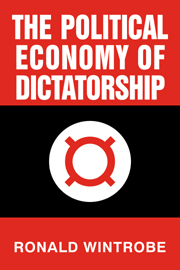Book contents
- Frontmatter
- Contents
- Dedication
- Acknowledgments
- Part I Introduction
- Part II Equilibrium political repression
- 3 The tinpot and the totalitarian
- 4 Tyranny and timocracy
- 5 A more general model
- Part III Economics of autocracy
- Part IV The dynamics of dictatorship
- Part V Conclusion
- References
- Name index
- Subject index
3 - The tinpot and the totalitarian
Published online by Cambridge University Press: 05 June 2012
- Frontmatter
- Contents
- Dedication
- Acknowledgments
- Part I Introduction
- Part II Equilibrium political repression
- 3 The tinpot and the totalitarian
- 4 Tyranny and timocracy
- 5 A more general model
- Part III Economics of autocracy
- Part IV The dynamics of dictatorship
- Part V Conclusion
- References
- Name index
- Subject index
Summary
Introduction
One of the most provocative and controversial contemporary studies of dictatorship was that of Jeane Kirkpatrick, in her book Dictatorship and Double Standards (1982). The essence of her argument, as already mentioned in Chapter 1, is that there are two kinds of dictatorships. The first type, commonly referred to as “totalitarian” dictatorship, is characterized by massive government intervention into the economic and social lives of the citizenry, an intervention motivated by Utopian goals of one kind or another and exemplified by Communist dictatorships, Nazi Germany, and possibly contemporary Iran. The second type is what Kirkpatrick, following Carl Friedrich and Zbigniew Brzezinski (1965), calls “traditional autocracies” and which I call “tinpot” dictatorships, ones in which the ruling government does not intervene very much into the life of the people, represses them only to the modest extent necessary to stay in office, and uses its rewards of monopoly of political power to maximize personal wealth or consumption. Examples include Anastasio Somoza of Nicaragua, the Shah of Iran, Ferdinand Marcos of the Philippines, and General Noriega of Panama. In short, in Kirkpatrick's model, the basic tool dictators use to remain in power is the instrument of repression, and tinpot and totalitarian dictatorships differ mainly in their level of repression.
Perhaps surprisingly, in view of the controversy generated by these ideas, very little effort has been made to answer the simple question: How much of the actual behavior of dictatorships can be explained with this type of model?
- Type
- Chapter
- Information
- The Political Economy of Dictatorship , pp. 43 - 76Publisher: Cambridge University PressPrint publication year: 1998



